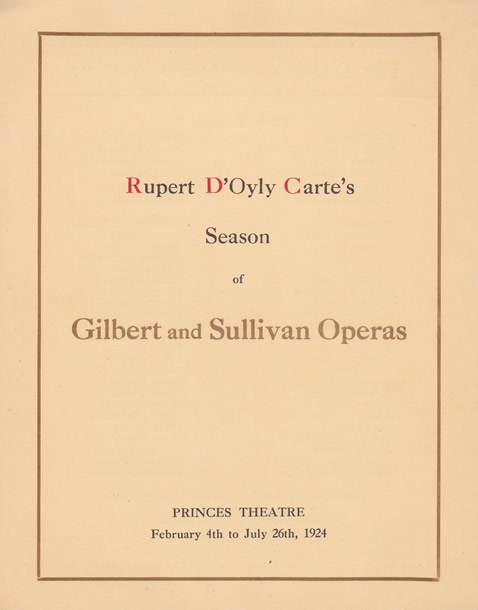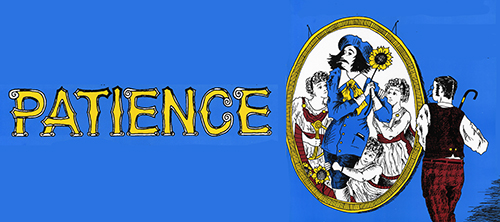La sixième collaboration de Gilbert & Sullivan fut "Patience". Le spectacle a été créé le 23 avril 1881 à l'Opéra Comique et a tenu l'affiche 578 représentations avant un transfert le 10 octobre 1881 dans le nouveau théâtre de D'Oyly Carte, le Savoy, premier théâtre au monde entièrement éclairé par des lumières électriques.
"Patience" fait la satire de l'engouement esthétique des années 1870 et 80, lorsque la production de poètes, compositeurs, peintres et designers de toutes sortes fut totalement prolifique - mais, selon certains, fut surtout creuse et complaisante. Ce mouvement artistique était si populaire, et aussi si facile à ridiculiser comme une mode sans signification, qu'il a fait de "Patience" un grand succès. Le lien avec cette actualité ponctuelle de l'histoire peut rendre "Patience" un peu moins accessible à certains publics modernes, et les fans de Gilbert & Sullivan ont tendance à avoir des sentiments excessivements tranchés - positifs ou négatifs - à propos de "Patience".
Romancier, Billy Magee fait un pari avec son riche ami qu’il peut écrire un roman en 24 heures. On lui remet une clé de l’auberge Baldpate, et on lui dit que c’est la seule (il s’avère qu’il y a sept personnes différentes qui revendiquent la propriété de la prétendue clé unique). À l’auberge, il déjoue un complot concernant un groupe de criminels, et juste avant minuit, apprend que l’intrigue entière est un canular (inventée par son riche ami pour l’empêcher de terminer le roman).
The opera is a satire on the aesthetic movement of the 1870s and '80s in England, part of the 19th-century European movement that emphasised aesthetic values over moral or social themes in literature, fine art, the decorative arts, and interior design. Called "Art for Art's Sake", the movement valued its ideals of beauty above any pragmatic concerns. Although the output of poets, painters and designers was prolific, some argued that the movement's art, poetry and fashion was empty and self-indulgent. That the movement was so popular and also so easy to ridicule as a meaningless fad helped make Patience a big hit. The same factors made a hit out of The Colonel, a play by F. C. Burnand based partly on the satiric cartoons of George du Maurier in Punch magazine. The Colonel beat Patience to the stage by several weeks, but Patience outran Burnand's play. According to Burnand's 1904 memoir, Sullivan's friend the composer Frederic Clay leaked to Burnand the information that Gilbert and Sullivan were working on an "æsthetic subject", and so Burnand raced to produce The Colonel before Patience opened. Modern productions of Patience have sometimes updated the setting of the opera to an analogous era such as the hippie 1960s, making a flower-child poet the rival of a beat poet.
The two poets in the opera are given to reciting their own verses aloud, principally to the admiring chorus of rapturous maidens. The style of poetry Bunthorne declaims strongly contrasts with Grosvenor's. The former's, emphatic and obscure, bears a marked resemblance to Swinburne's poetry in its structure, style and heavy use of alliteration. The latter's "idyllic" poetry, simpler and pastoral, echoes elements of Coventry Patmore and William Morris. Gilbert scholar Andrew Crowther comments, "Bunthorne was the creature of Gilbert's brain, not just a caricature of particular Aesthetes, but an original character in his own right." The makeup and costume adopted by the first Bunthorne, George Grossmith, used Swinburne's velvet jacket, the painter James McNeill Whistler's hairstyle and monocle, and knee-breeches like those worn by Oscar Wilde and others.
According to Gilbert's biographer Edith Browne, the title character, Patience, was made up and costumed to resemble the subject of a Luke Fildes painting. Patience was not the first satire of the aesthetic movement played by Richard D'Oyly Carte's company at the Opera Comique. Grossmith himself had written a sketch in 1876 called Cups and Saucers that was revived as a companion piece to H.M.S. Pinafore in 1878, which was a satire of the blue pottery craze.
A popular misconception holds that the central character of Bunthorne, a "Fleshly Poet," was intended to satirise Oscar Wilde, but this identification is retrospective. According to some authorities, Bunthorne is inspired partly by the poets Algernon Charles Swinburne and Dante Gabriel Rossetti, who were considerably more famous than Wilde in early 1881 before Wilde published his first volume of poetry. Rossetti had been attacked for immorality by Robert Buchanan (under the pseudonym "Thomas Maitland") in an article called "The Fleshly School of Poetry", published in The Contemporary Review for October 1871, a decade before Patience. Nonetheless, Wilde's biographer Richard Ellmann suggests that Wilde is a partial model for both Bunthorne and his rival Grosvenor. Carte, the producer of Patience, was also Wilde's booking manager in 1881 as the poet's popularity took off. In 1882, after the New York production of Patience opened, Gilbert, Sullivan and Carte sent Wilde on a US lecture tour, with his green carnation and knee-breeches, to explain the English aesthetic movement, intending to help popularise the show's American touring productions.
Although a satire of the aesthetic movement is dated today, fads and hero-worship are evergreen, and "Gilbert’s pen was rarely sharper than when he invented Reginald Bunthorne". Gilbert originally conceived Patience as a tale of rivalry between two curates and of the doting ladies who attended upon them. The plot and even some of the dialogue were lifted straight out of Gilbert's Bab Ballad "The Rival Curates." While writing the libretto, however, Gilbert took note of the criticism he had received for his very mild satire of a clergyman in The Sorcerer, and looked about for an alternative pair of rivals. Some remnants of the Bab Ballad version do survive in the final text of Patience. Lady Jane advises Bunthorne to tell Grosvenor: "Your style is much too sanctified – your cut is too canonical!" Later, Grosvenor agrees to change his lifestyle by saying, "I do it on compulsion!" – the very words used by the Reverend Hopley Porter in the Bab Ballad. Gilbert's selection of aesthetic poet rivals proved to be a fertile subject for topsy-turvy treatment. He both mocks and joins in Buchanan's criticism of what the latter calls the poetic "affectations" of the "fleshly school" – their use of archaic terminology, archaic rhymes, the refrain, and especially their "habit of accenting the last syllable in words which in ordinary speech are accented on the penultimate." All of these poetic devices or "mediaevalism's affectations", as Bunthorne calls them, are parodied in Patience. For example, accenting the last syllable of "lily" and rhyming it with "die" parodies two of these devices at once.
On 10 October 1881, during its original run, Patience transferred to the new Savoy Theatre, the first public building in the world lit entirely by electric light. Carte explained why he had introduced electric light: "The greatest drawbacks to the enjoyment of the theatrical performances are, undoubtedly, the foul air and heat which pervade all theatres. As everyone knows, each gas-burner consumes as much oxygen as many people, and causes great heat beside. The incandescent lamps consume no oxygen, and cause no perceptible heat." When the electrical system was ready for full operation, in December 1881, Carte stepped on stage to demonstrate the safety of the new technology by breaking a glowing lightbulb before the audience.
Colonel Calverley (Officer of Dragoon Guards) (bass-baritone)
Major Murgatroyd (Officer of Dragoon Guards) (baritone)
Lieut. The Duke of Dunstable (Officer of Dragoon Guards) (tenor)
Reginald Bunthorne (a Fleshly Poet) (comic baritone)
Archibald Grosvenor (an Idyllic Poet) (lyric baritone)
Mr. Bunthorne's Solicitor (silent)
The Lady Angela (Rapturous Maiden) (mezzo-soprano)
The Lady Saphir (Rapturous Maiden) (mezzo-soprano or soprano)
The Lady Ella (Rapturous Maiden) (soprano)
The Lady Jane (Rapturous Maiden) (contralto)
Patience (a Dairy Maid) (soprano)
Chorus of Rapturous Maidens and Officers of Dragoon Guards
Aucun dossier informatif complémentaire concernant Patience

Version 1
Patience (1919-09-Prince's Theatre-London) G&S Season
Type de série: RevivalThéâtre: Shaftesbury Theatre (Londres - Angleterre) Durée : 4 mois Nombre : Première Preview : lundi 29 septembre 1919Première : lundi 29 septembre 1919Dernière : samedi 31 janvier 1920Mise en scène : Chorégraphie : Producteur : D'Oyly Carte Opera Company • Presse : "L'admirable compagnie se distingue par l'inclusion d'un nouveau ténor, M. Derek Oldham, dont la présence et les manières agréables, les capacités d'acteur et la voix exquise ravissent autant que celles de n'importe quel Marco que j'ai vu et entendu. Le duc de M. Henry Lytton, le Don Alhambra de M. Leo Sheffield et la duchesse de Miss Bertha Lewis sont tous en accord avec les traditions du pays, tandis que Miss Elsie Griffin et Miss Nellie Briercliffe formaient un couple d'épouses satisfaisant. L'enthousiasme du public était sans limite." - London Sunday Times
"Après quatre années de guerre et les misères qui en découlent, que se soucie le public britannique d'un inconvénient aussi insignifiant qu'une simple grève des chemins de fer ? Certainement pas assez pour se permettre d'être tenu à l'écart d'un événement aussi primordial que la reprise de Gilbert et Sullivan au Prince's Theatre, où un public immense était venu accueillir l'excellente compagnie de M. D'Oyly Carte lors de sa première visite au centre de Londres. C'était un public brillant et il comprenait non seulement de nombreuses personnalités sociales, théâtrales et musicales de l'époque, mais aussi un certain nombre de ces vieux Savoyards aux noms desquels les opéras de Gilbert et de Sullivan doivent toujours être irrévocablement associés. Miss Jessie Bond, Miss Geraldine Ulmar et M. Rutland Barrington étaient tous là." - Daily Telegraph

Version 2
Patience (1924-02-Prince's Theatre-London) G&S Season
Type de série: RevivalThéâtre: Shaftesbury Theatre (Londres - Angleterre) Durée : 5 mois 3 semaines Nombre : Première Preview : lundi 04 février 1924Première : lundi 04 février 1924Dernière : samedi 26 juillet 1924Mise en scène : Chorégraphie : Producteur : D'Oyly Carte Opera Company •
Pas encore de video disponible pour ce spectacle
